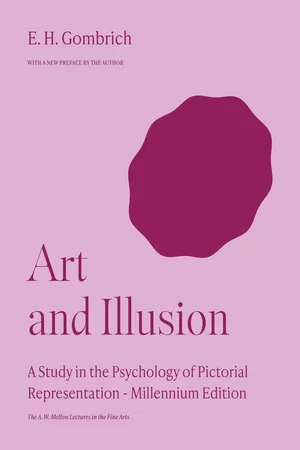
Art and Illusion
A Study in the Psychology of Pictorial Representation - Millennium Edition
- 512 pages
- English
- PDF
- Available on iOS & Android
Art and Illusion
A Study in the Psychology of Pictorial Representation - Millennium Edition
About this book
A groundbreaking account of perception and art, from one of the twentieth century's most important art historians
E. H. Gombrich is widely considered to be one of the most influential art historians of the twentieth century, and Art and Illusion is generally agreed to be his most important book. Bridging science and the humanities, this classic work examines the history and psychology of pictorial representation in light of modern theories of information and learning in visual perception. Searching for a rational explanation of the changing styles of art, Gombrich reexamines ideas about the imitation of nature and the function of tradition. In testing his arguments, he ranges over the history of art, from the ancient Greeks, Leonardo, and Rembrandt to the impressionists and the cubists. But the triumphant originality of Art and Illusion is that Gombrich is less concerned with the artists than with the psychological experience of the viewers of their work.
Please note: All images in this ebook are presented in black and white and have been reduced in size.
Frequently asked questions
- Essential is ideal for learners and professionals who enjoy exploring a wide range of subjects. Access the Essential Library with 800,000+ trusted titles and best-sellers across business, personal growth, and the humanities. Includes unlimited reading time and Standard Read Aloud voice.
- Complete: Perfect for advanced learners and researchers needing full, unrestricted access. Unlock 1.4M+ books across hundreds of subjects, including academic and specialized titles. The Complete Plan also includes advanced features like Premium Read Aloud and Research Assistant.
Please note we cannot support devices running on iOS 13 and Android 7 or earlier. Learn more about using the app.
Information
Table of contents
- Cover
- Title
- Copyright
- Dedication
- CONTENTS
- PREFACE
- PREFACE TO THE SECOND EDITION
- LIST OF ILLUSTRATIONS
- Introduction: Psychology and the Riddle of Style
- PART ONE: THE LIMITS OF LIKENESS
- PART TWO: FUNCTION AND FORM
- PART THREE : THE BEHOLDER’S SHARE
- PART FOUR: INVENTION AND DISCOVERY
- Retrospect
- NOTES
- INDEX